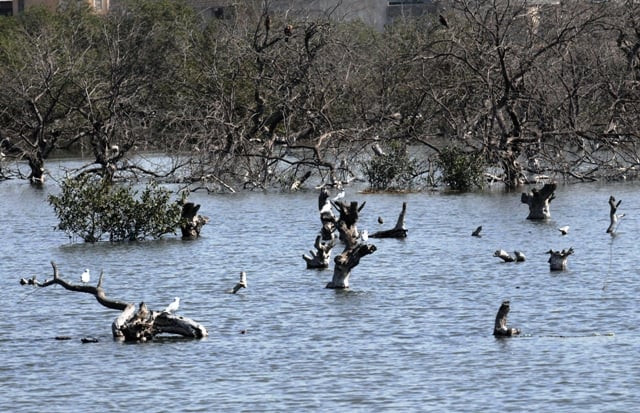
The Cantonment Board Clifton (CBC) has chipped off mangroves planted along Sea View to make space for a park – even though experts claim the park will not be able to bear high tides and wind.
Tractors are rooting out the mangroves planted at the Avicennia marina on a daily basis and they lie in a heap at the corner of the wall that runs from McDonald’s towards the Village restaurant.
This will make way for a park which is informally being called the Beach Park. Spread over 5.5 acres, it comprises a few benches and a public lavatory, which is still under construction.
“Who cares about trees?” said Tariq Qureshi, a senior adviser for the International Union for Conservation of Nature (IUCN). “Someone must question CBC’s wisdom as no breed except for mangroves can survive on the coastal belt.”
Thousands of mangroves were planted on four acres of beach in 2005 as part of a Defence Housing Authority (DHA) drive to plant trees on the coast, he said.
An employee of the CBC’s gardens department, Muhammad Khalid, insists that only about a dozen mangrove trees have been removed. “We will plant more mangroves, which will be brought from the Mai Kolachi area.”
The new Beach Park is being developed on a piece of land which was vacant for years. Previous attempts to develop a park there failed. “We are watering the grass three times a day,” Khalid said. The park management tried to experiment with plants but all of them died due to high winds, he said. “Now we are planting Conocorpus trees.”
However, Khalid could not say how the mangroves are planted. Since the tree grows where the river meets seawater, artificially farming mangroves is difficult.
The size of the mangroves on Sindh’s coastal belt has shrunk to 41,000 hectares from nearly 600,000 hectares in 1980, with the gradual decrease in flow of River Indus and intrusion of seawater up the channel.
IUCN’s Qureshi said that his team has to create a natural pond for growing mangroves at the beach. “When DHA first asked me, I carried out a survey to find the right spot and it took me quite some time.
IUCN realised that there was a point from where a sewerage pipeline of the nearby Sea View apartments was meeting the sea, he said. “Sewerage was used to make right composition of soil and then mangrove seeds were planted.”
Mangroves act as a natural defence against cyclones and IUCN says that these trees helped save a considerable number of lives when the tsunami hit Indonesia and other countries.”
They also help stop sea intrusion. “Seawater has intruded 54 kilometers into the land, destroying marine life and displacing communities,” said Qureshi. “If we don’t do something now, sea intrusion will reach Kotri barrage. The river is all sea at Thatta.”
He also alleged that CBC officials have ignored past trends and events, including when tidal waves have reached the main Sea View road. He predicts that the “entire park will be wiped off”.
Karachi’s coastal belt - as it exists today - is on the land reclaimed from sea, which once used to touch the steps of Abdullah Shah Ghazi’s shrine.
Published in The Express Tribune, December 29th, 2011.








1725429132-0/Untitled-design-(12)1725429132-0-270x192.webp)









COMMENTS
Comments are moderated and generally will be posted if they are on-topic and not abusive.
For more information, please see our Comments FAQ